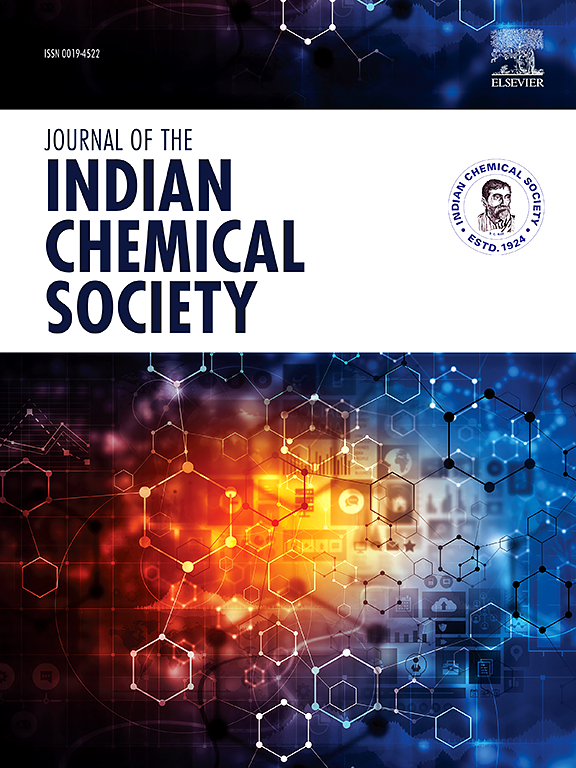用于开发大功率密度超级电容器的高性能纳米晶三元锡镍银合金电镀材料
IF 3.2
4区 化学
Q2 CHEMISTRY, MULTIDISCIPLINARY
引用次数: 0
摘要
本文采用直流电化学沉积的方法,在铜箔集流电极上制备了用于超级电容器的三元Sn-Ni-Ag纳米合金材料。在这方面,三元合金的化学计量成分比二元材料(如Sn-Ni合金)具有更好的性能。实际上,利用Tin (Sn)具有优异的导电性,可以显著提高电容,但可逆性差,镍(Ni)有助于提高机械强度,而银(Ag)具有优异的导电性,并主要提高Sn粒子的储能和转换能力。因此,本工作重点制备了Sn-Ni-Ag合金电极材料,并分别采用x射线衍射(XRD)和场发射扫描电镜(FE-SEM)结合能量色散x射线能谱(EDX)对其进行了表征。Sn-Ni-Ag沉积厚度为17 μm,排列致密,颗粒分布均匀,具有良好的结晶结构。Cu与活性Sn-Ni-Ag材料之间的沉积具有很强的粘附性,粒径约为100 nm。利用循环伏安法(CV)和电化学阻抗谱(EIS)对电容器的电化学性能进行了评估,两者都证实了电容器的稳健性能,表明其适合储能应用。在1 mV s−1的扫描速率下,电沉积Sn-Ni-Ag合金电极的最大比电容约为694 F g−1,超过5000次循环,显示出良好的活性材料利用率,在先进储能技术特别是超级电容器应用中具有良好的潜力。本文章由计算机程序翻译,如有差异,请以英文原文为准。

High performing nano-crystalline ternary Sn–Ni–Ag alloy electroplated material for development of high-power density supercapacitor
In present work, synthesis and development of ternary Sn–Ni–Ag nanostructured alloy material, deposited on a Cu foil current collector as an electrode using direct current (DC) electrochemical deposition, for application in supercapacitor. In this regards, stoichiometric composition of ternary alloy is better performing than that of binary materials like Sn–Ni alloys. Indeed, Tin (Sn) is utilized for its excellent electrical conductivity, which significantly enhances capacitance, but poor reversibility behavior, nickel (Ni) contributes to mechanical strength, while silver (Ag) imparts superior conductivity, and improved energy storage and conversion capabilities mainly Sn particle. Therefore, this work focuses on Sn–Ni–Ag alloy electrode materials have been prepared and characterized using X-ray diffraction (XRD) and field emission scanning electron microscopy (FE-SEM) combined with energy-dispersive X-ray spectroscopy (EDX), respectively. The Sn–Ni–Ag deposition thickness of 17 μm, featuring densely packed, and particles are uniformly distributed with a well-crystallized structure. The deposition between Cu and active Sn–Ni–Ag material is a strong adhesion with a particle size of approximately 100 nm. Electrochemical performance was evaluated using cyclic voltammetry (CV) and electrochemical impedance spectroscopy (EIS), both of which confirmed robust capacitor behavior, indicating suitability for energy storage applications. The maximum specific capacitance of electrodeposited Sn–Ni–Ag alloy electrode delivered to be approximately 694 F g−1 at a scan rate of 1 mV s−1, over 5000 cycles demonstrating an excellent utilization of active materials, it's highlighting a good and potential candidate in the advanced energy storage technologies especially for supercapacitor application.
求助全文
通过发布文献求助,成功后即可免费获取论文全文。
去求助
来源期刊
CiteScore
3.50
自引率
7.70%
发文量
492
审稿时长
3-8 weeks
期刊介绍:
The Journal of the Indian Chemical Society publishes original, fundamental, theorical, experimental research work of highest quality in all areas of chemistry, biochemistry, medicinal chemistry, electrochemistry, agrochemistry, chemical engineering and technology, food chemistry, environmental chemistry, etc.

 求助内容:
求助内容: 应助结果提醒方式:
应助结果提醒方式:


